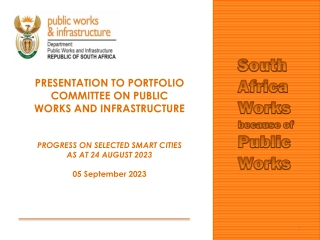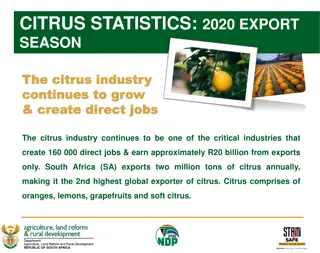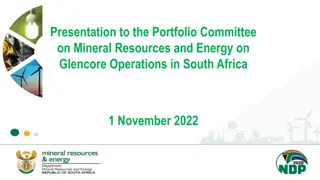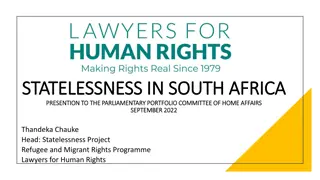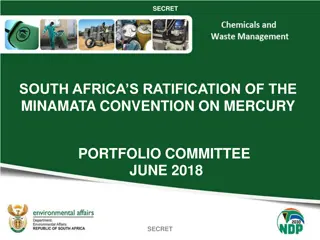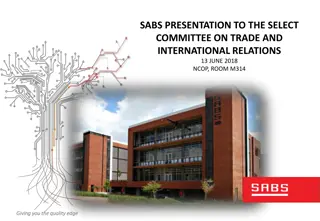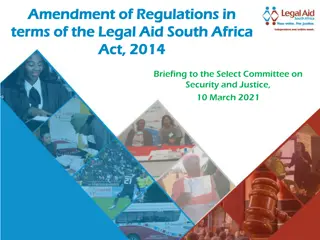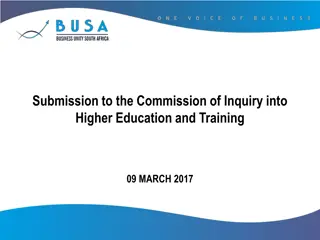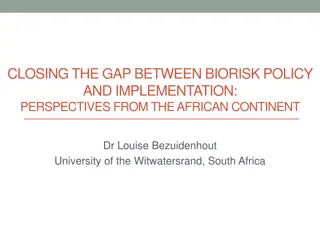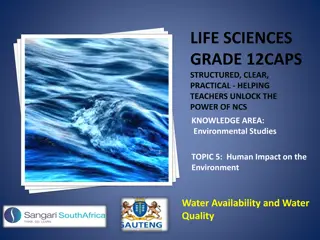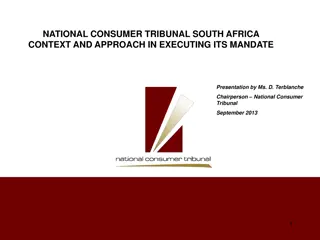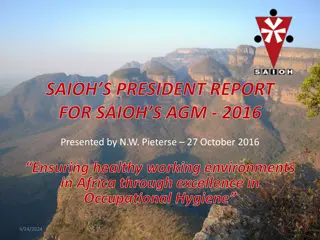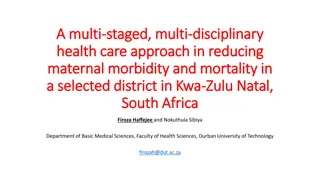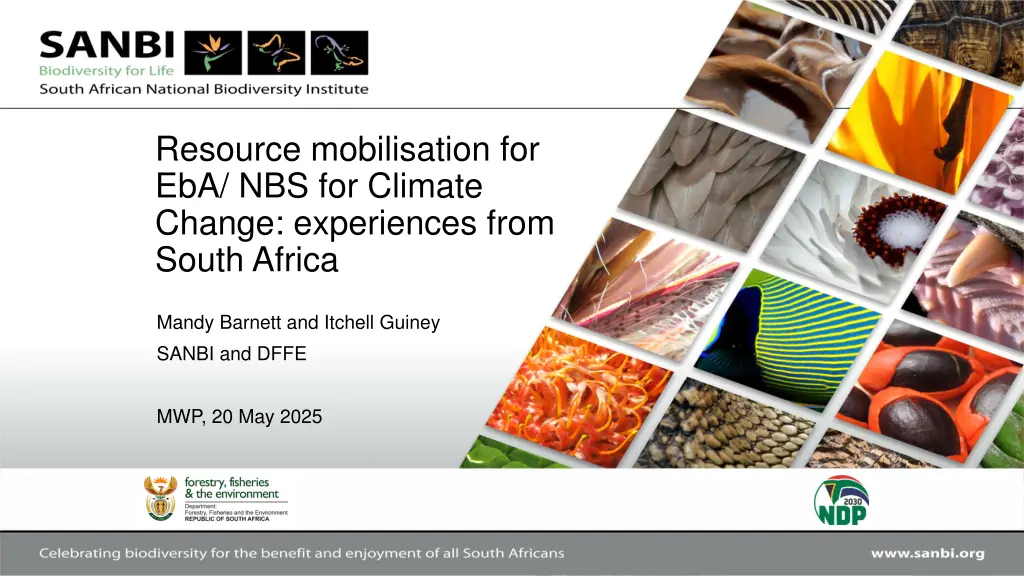
Climate Change Mitigation Opportunities in South Africa
Explore the various climate change mitigation opportunities in South Africa, including restoration projects, afforestation, biomass energy initiatives, and more. Discover how these efforts aim to reduce emissions and enhance environmental sustainability across different ecosystems and land types in the country.
Download Presentation

Please find below an Image/Link to download the presentation.
The content on the website is provided AS IS for your information and personal use only. It may not be sold, licensed, or shared on other websites without obtaining consent from the author. If you encounter any issues during the download, it is possible that the publisher has removed the file from their server.
You are allowed to download the files provided on this website for personal or commercial use, subject to the condition that they are used lawfully. All files are the property of their respective owners.
The content on the website is provided AS IS for your information and personal use only. It may not be sold, licensed, or shared on other websites without obtaining consent from the author.
E N D
Presentation Transcript
Resource mobilisation for EbA/ NBS for Climate Change: experiences from South Africa Mandy Barnett and Itchell Guiney SANBI and DFFE MWP, 20 May 2025
SA climate change context (IPCC) Highly vulnerable to CC SA increase in temp double that of the global mean Increase in droughts (Especially western part) Recent estimates suggest that human-induced climate change was responsible for almost 44% of heat-related deaths in South Africa (1991 2018). Extreme heat days have increased across South African national parks since the 1990s. Woody plants have increased by 10% on subsistence grazing lands and 20% on economically important grazing lands in South Africa in the last 60 years (Bush encroachment)
CC Policy Environment NCCRP White Paper (2011) South Africa s climate change approach Main policy directive for land sector Climate Change Act Chapter 5 (land sector included in SETs) Linkages to biodiversity policies and land degradation, as well as EbA
Brief summary -SA National Sinks Holistic approach Land as a system Carbon and non-carbon benefits Main focus Restore ecosystem functions, livelihoods, SD, PE Work since 2011 NTCSA (4 updates) 3 objectives NTCSA web based atlas Needs to be more dynamic (NMS)
The eight principal CC mitigation opportunities The eight principal CC mitigation opportunities Spatial extent (ha) Emission reduction per yr (tCO2e) (min) Reduction over 20yr (tCO2e) (min) Activity Sub-class Sub-tropical thicket 500 000 2 200 000 44 000 000 Restoration of sub-tropical thicket, forests and woodlands Coastal and scarp forests 8 570 56 562 1 131 240 Broadleaf woodland 300 000 1 210 000 24 200 000 Restoration - Erosion Mesic 270 000 693 000 13 860 000 Restoration - Erosion Dry 320 000 586 667 11 733 333 Restoration and management of grasslands Restoration - Grasslands Mesic 600 000 1 100 000 22 000 000 Avoided degradation mesic 15 000 55 000 1 100 000 Eastern Cape 60 000 330 000 2 750 000 Commercial small-grower afforestation KwaZulu-Natal 40 000 220 000 1 833 333 Biomass energy (IAPs & bush encroachment) Country-wide 1 990 316 39 806 316 Biomass energy (bagasse) Country-wide 328 955 6 579 099 Anaerobic biogas digesters Country-wide 3 642 408 72 848 160 Biochar 700 000 641 667 12 833 333 Reduced tillage 2 878 960 1 055 619 21 112 373 Through planning Reducing deforestation and degradation Through regulation Total 14 110 193 275 787 189
Main challenges Data deficiencies Partially addressed Issues with LUC datasets CALC not backward looking MAIN CONSTRAINT funding for final pieces of work towards partial implementation and also upscale over time Useful if this process could address ex ante finance needs dev of systems, infrastructure and implementation
South African National Biodiversity Institute (SANBI) Home SANBI is an entity of the National Department of Forestry, Fisheries and Environment a government entity with a biodiversity science/ policy mandate SANBI is one of two South African entities who are accredited at Direct Access Entities with the Green Climate Fund Logo Green Climate Fund This positions SANBI perfectly to work at the biodiversity/ climate change nexus: SANBI explicitly champions Ecosystem based Adaptation, and implicitly champions ecosystem/ biodiversity-linked Mitigation
Taking Adaptation to the Ground: A Small Grants Facility for enabling local level responses to climate change (USD 2.5 million,6.5 years) 12 community- level project grants, of approx. USD100 000 each Climate resilient livelihoods, climate proof settlements and climate smart agriculture investments 1921 direct and 9006 indirect project beneficiaries 525 tangible assets A methodology for cascading climate finance to the local level How? Communities empowered to develop their own adaptation responses Funds provided directly to communities or their selected intermediaries Local level governance systems established to support decision making, coordination and alignment Capacity building and extension support throughout (and beyond) Home
The problems: Due to changing climatic conditions, the local livestock breeds have struggled to cope with extreme hot and cold temperatures. Negative impacts on livestock production (predominantly sheep and goats), affecting food and livelihood security. Rangelands and wetlands degraded by inappropriate land practices which are exacerbated by climate change and poor grazing methods The solutions: Project introduced a breed of climate-resilient livestock which are heat and drought tolerant, and the implementation of sound grazing management regimes to maintain fodder availability for livestock and prevent further degradation of natural resources. Explicit adaptation benefits, and implicit mitigation co- benefits associated with sustainable land management 92 direct, 1030 indirect beneficaries (Mitigation benefits not quantified but they could be )
Over the 6 years of implementation, the project learned how to (and sometimes how not to) learned how to (and sometimes how not to) cascade climate finance to the local level, cascade climate finance to the local level, and developed a set of recommendations and developed a set of recommendations for scaling up. the project With the body of evidence that has been generated through the project, plans are well underway to scale the work underway to scale the work through a further AF project, and through a new national fund that is emerging in South Africa. plans are well
Building resilience in the Greater uMngeni Catchment, South Africa (USD 7.5 million, 8.5 years) Four interconnected components: Multi-hazard EWS Climate resilient agriculture Built and Ecological Infrastructure Knowledge management and policy Led by sub-national government, in partnership with Academia and civil society Home Closed in March 2024 102,855 beneficiaries (against a target of 25,000)
uMngeni Catchment, South Africa The problems: Temperature increases Increase in extreme storm and flood events Seasonal shifts and later onset of summer rains The solutions: Invasive alien plant removal to tackle bush encroachment, reduce risk from wild fires and increase food security Rehabilitating grasslands to improve grazing capacity, flood attenuation and groundwater recharge Small holder farmer support through crop variety introductions, irrigation support and market access Explicit NBS/ EbA, implicit mitigation co-benefits
Currently scaling. Through three EbA proposals cleared by the GCF secretariat for full development .. all with mitigation co-benefits USD 90 million grant request important opportunity for making the case
Insights: Adopt a systems approach Climate change responses must be seen in the context of sustainable development address multiple problems with integrated solutions Respect and empower local action, devolve decision making to lowest possible level, while simultaneously investing in the enabling environment for replication and scaling Mitigation co-benefits (almost) always occur with EbA

